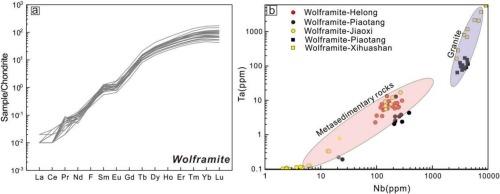和龙石英脉型钨铜矿床流体演化与成矿机制:流体包裹体显微测温与矿物原位地球化学分析
IF 3.6
2区 地球科学
Q1 GEOLOGY
引用次数: 0
摘要
和龙钨铜矿床位于南岭地区,属石英脉型钨、铜成矿。和龙矿床是一个多金属成矿的典型例子,其特征是钨和铜资源丰富且具有经济价值。具体来说,它拥有4万吨WO3和2000吨Cu的大量储量,突出了它的双金属禀赋。确定了以黑钨矿-石英脉、白钨矿-石英脉和黄铜矿-石英脉为特征的3个成矿阶段。我们采用流体包裹体显微测温和矿物原位微量元素分析等技术来探索W和Cu成矿流体的性质。分析结果表明,在与黄铜矿伴生的黑钨矿、白钨矿和石英中均记录有以液体为主的水包裹体。这些以液体为主的含水流体包裹体包含一个蒸汽泡,其余部分由液态NaCl-H2O占据。显微测温分析表明,早期黑钨矿流体包裹体均一温度为294 ~ 338℃,均一盐度为6.4 ~ 8.9 wt% NaCl当量,表明早期成矿流体具有高温中盐度特征。均质温度范围广,表明流体的自然冷却是引发黑钨矿沉淀的主要因素。从黑钨矿阶段过渡到白钨矿阶段,流体包裹体均一温度和盐度持续下降,表明白钨矿的沉淀可能是流体混合作用的结果,并伴有流-岩相互作用。与黄铜矿伴生的石英流体包裹体均一温度为194 ~ 233℃,盐度为4.4 ~ 6.1 wt% NaCl当量,表明流体演化的最新阶段以低温低盐度为特征。没有沸腾流体包裹体组合(这表明相分离)和相对较宽的均质温度范围表明,简单的冷却-而不是流体沸腾或混合-是黄铜矿沉淀的主要机制。黑钨矿富集重稀土元素(HREE)和Nb、Ta等高场强元素,呈典型的左倾模式。这一模式与黑钨矿中稀土元素分配的晶体化学机制(即重稀土元素相对于轻稀土元素优先进入其晶格)相结合,表明黑钨矿的成矿流体来源于高分馏的花岗质岩浆——与分馏花岗质中析出的富稀土流体的地球化学特征一致。多数白钨矿样品呈现典型的Eu正异常,Mo含量低,表明其处于还原流体环境。然而,少数白钨矿样品呈现负Eu异常,表明白钨矿结晶发生在动态氧化还原条件下。本文章由计算机程序翻译,如有差异,请以英文原文为准。

Fluid evolution and mineralization mechanisms in Helong quartz vein-type W-Cu deposit: insights from fluid inclusion microthermometry and in situ geochemical analysis of minerals
The Helong W-Cu deposit, located within the Nanling region, contains quartz vein type W and Cu mineralization. The Helong deposit is a prime example of a polymetallic mineralization characterized by significant and economically valuable resources of both W and Cu. Specifically, it hosts substantial reserves of 40,000 tonnes of WO3 and 2000 tonnes of Cu, highlighting its dual-metal endowment. Three mineralization stages were identified, characterized by wolframite-quartz veins, scheelite-quartz veins and chalcopyrite-quartz veins, respectively. We employed techniques such as fluid inclusion microthermometry and in situ trace element analysis of minerals to explore the nature of the fluids responsible for W and Cu mineralization. The analytical results reveal that liquid-dominated aqueous fluid inclusions are recorded in both wolframite, scheelite and quartz associated with chalcopyrite. These liquid-dominated aqueous fluid inclusions contain a vapor bubble, with the remainder occupied by liquid NaCl-H2O. Microthermometric analyses indicate that the fluid inclusions in the early-stage wolframite have homogenization temperatures and salinities of 294–338 °C and 6.4–8.9 wt% NaCl equivalent, respectively, suggesting that the early-stage ore-forming fluid was characterized by high temperature and medium salinity. The broad range of homogenization temperatures suggests that natural cooling of the fluid was the primary factor triggering the precipitation of wolframite. The transition from the wolframite stage to the scheelite stage is characterized by a consistent decrease in the homogenization temperatures and salinities of fluid inclusions, suggesting that the precipitation of scheelite may be attributed to fluid mixing, which may be accompanied by fluid-rock interaction. Fluid inclusions in quartz associated with chalcopyrite have homogenization temperatures of 194–233 °C and salinities of 4.4–6.1 wt% NaCl equivalent, indicating that the latest stage of fluid evolution was characterized by low temperature and low salinity. The absence of boiling fluid inclusion assemblages (which would indicate phase separation) and the relatively broad range of homogenization temperatures suggest that simple cooling—rather than fluid boiling or mixing—was the primary mechanism for chalcopyrite precipitation. Wolframite is significantly enriched in heavy rare earth elements (HREE) and high field strength elements such as Nb and Ta, exhibiting a typical left-leaning pattern. This pattern, coupled with the crystal-chemical mechanism of REE partitioning in wolframite (i.e., preferential incorporation of HREE into its crystal lattice relative to LREE), suggests that the ore-forming fluid for wolframite was derived from a highly fractionated granitic magma—consistent with the geochemical signatures of HREE-enriched fluids exsolved from fractionated granitoids. Most scheelite samples display a typical positive Eu anomaly and have low Mo contents, suggesting a reducing fluid environment. However, a small number of scheelite samples exhibit negative Eu anomalies, indicating that scheelite crystallization occurred under dynamic redox conditions.
求助全文
通过发布文献求助,成功后即可免费获取论文全文。
去求助
来源期刊

Ore Geology Reviews
地学-地质学
CiteScore
6.50
自引率
27.30%
发文量
546
审稿时长
22.9 weeks
期刊介绍:
Ore Geology Reviews aims to familiarize all earth scientists with recent advances in a number of interconnected disciplines related to the study of, and search for, ore deposits. The reviews range from brief to longer contributions, but the journal preferentially publishes manuscripts that fill the niche between the commonly shorter journal articles and the comprehensive book coverages, and thus has a special appeal to many authors and readers.
 求助内容:
求助内容: 应助结果提醒方式:
应助结果提醒方式:


